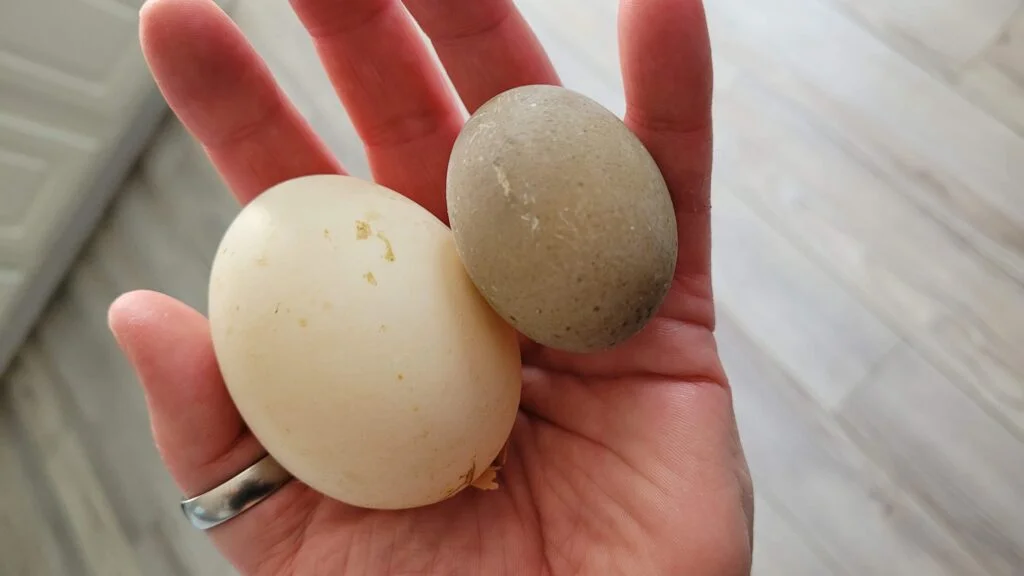
How Often Do Ducks Lay Eggs? Breaking Down Duck Egg Production and More
Last updated on February 6th, 2025 at 07:17 pm
Today, we’re delving into the practical realm of duck egg production. Have you ever wondered, “How often do ducks lay eggs?” It’s a common question among duck enthusiasts, and rightly so. Understanding the frequency of egg laying is crucial for any duck keeper.
This blog post will take a methodical approach to breaking down the factors affecting duck egg production. From breed disparities to age considerations, we’ll navigate the variables influencing how often our feathered friends grace us with their nutritious eggs. Additionally, we’ll explore the specific laying frequencies observed in different duck breeds, providing you with valuable insights into managing your own flock.
Let’s dive into the frequency of duck egg production, the colors you might expect, and their nutritional benefits.

Disclaimer: I may earn a commission if you buy products or services through my affiliate links. This will not affect the price you pay. I only recommend products or services that I believe will be beneficial to my readers.
Factors Affecting Duck Egg Production
Before we delve into specifics, it’s crucial to recognize that several factors influence how often ducks lay eggs:
Duck Egg Frequency is Breed Related
Duck egg frequency isn’t a one-size-fits-all scenario; it’s intricately tied to the duck breed in question. Different duck breeds exhibit varying levels of egg production, influenced by genetic predispositions and historical purposes.
For instance, prolific layers like the Khaki Campbells and the Runner ducks are known to lay eggs frequently, sometimes even year-round. Conversely, breeds primarily bred for meat or ornamental purposes, such as Muscovies or Pekins, may have lower egg production rates.
Understanding the breed-specific traits and tendencies is key for duck keepers seeking to optimize egg production within their flock. By selecting breeds aligned with their egg-laying goals and providing appropriate care, duck enthusiasts can maximize the yield of their feathered companions’ nutritious eggs.
The Influence of Age on Duck Egg Production
Age plays a significant role in duck egg production frequency. Young ducks, particularly in their prime laying years, typically exhibit higher egg production rates than their older counterparts.
Ducks typically start laying eggs at around five to six months of age, reaching peak production between seven months and one year. However, egg production declines gradually as ducks age beyond their prime laying years.
Ducks eventually reach a point in their egg production journey where they stop laying. While the exact age at which ducks stop laying eggs can vary depending on factors like breed, health, and environmental conditions, it’s common for egg production to taper off as ducks reach their senior years. Typically, ducks may continue laying eggs up to around 8-10 years of age, but this can vary.
Factors such as genetics, nutrition, and overall health play significant roles in determining the longevity of egg-laying ducks. Duck keepers must be mindful of their ducks’ well-being as they age and provide appropriate care and accommodations to ensure their comfort and health in their later years.

Seasonal Influence on Duck Egg Laying
The frequency of duck egg laying exhibits notable fluctuations in response to seasonal changes. During the spring and summer months, characterized by longer daylight hours and increased foraging opportunities, ducks typically experience heightened egg production. This egg-laying surge is attributed to the longer photoperiod, which stimulates hormonal activity and encourages reproductive behaviors.
Conversely, duck egg production tends to decrease as the days shorten and temperatures drop in the autumn and winter seasons. The reduced daylight hours trigger physiological changes in ducks, leading to a natural decline in egg laying. This adaptive response allows ducks to conserve energy and allocate resources more efficiently during periods of environmental stress.
Recognizing the seasonal influences on duck egg laying is crucial for duck keepers, enabling them to anticipate and adapt to fluctuations in egg production throughout the year. By aligning management practices with the natural rhythms of their flock, duck enthusiasts can optimize egg yield and promote the overall well-being of their feathered companions.
Environmental Factors Affecting Duck Egg Production
Various environmental conditions profoundly influence duck egg production, ranging from habitat dynamics to stressors within their surroundings. These factors intricately shape ducks’ reproductive behavior and physiological responses, ultimately impacting egg-laying frequency and consistency.
- Habitat Quality: The quality and availability of habitat resources directly influence duck reproductive success. Ducks require access to suitable nesting sites, abundant food sources, and clean water to thrive and sustain optimal egg production. Environmental factors such as habitat loss, pollution, and habitat degradation can disrupt nesting behaviors and diminish egg-laying rates among duck populations.
- Climate Variability: Climate fluctuations, including temperature extremes, precipitation patterns, and weather events, can profoundly affect duck egg production. Extreme heat or cold stress can disrupt reproductive physiology and diminish egg quality, while prolonged periods of drought or heavy rainfall may impact food availability and nesting conditions, influencing overall reproductive success.
- Environmental Stressors: Ducks are sensitive to various environmental stressors, including disturbances from human activities, predation pressure, and habitat alterations. Chronic stressors can negatively impact reproductive hormone levels and disrupt normal egg-laying patterns, reducing egg production and reproductive fitness among duck populations.
By comprehensively understanding and proactively managing these environmental factors, duck enthusiasts can create conducive conditions for optimal egg production and support their feathered companions’ long-term health and vitality.
Typical Duck Egg-Laying Frequencies
So, how often do ducks lay eggs? While there’s no one-size-fits-all answer, here’s a general overview based on common duck breeds:
| Duck Breed | Average Annual Egg Production | Egg Size |
| Ancona | 210-280 | 80 – 90 grams |
| Black and Blue Swedish | 100-150 | 80 – 95 grams |
| Buff | 150-220 | 80 – 90 grams |
| Call | 25-75 | 40 – 55 grams |
| Cayuga | 130-180 | 75 – 90 grams |
| Golden 300 Hybrid Layer Ducks | 200-290 | 75 – 90 grams |
| Indian Runner | 150-300 | 65 – 80 grams |
| Jumbo Pekin | 140-175 | 90 – 100 grams |
| Khaki Campbell | 250-340 | 75 – 85 grams |
| Magpie | 220-290 | 65 – 72 grams |
| Muscovy | 60-120 | 75 – 85 grams |
| Silver Appleyard | 200-270 | 80 – 95 grams |
| Welsh Harlequin | 240-330 | 75 – 85 grams |
| White Crested | 100-150 | 80 – 90 grams |
Khaki Campbell and Wesh Harlequin ducks are the clear leaders in egg laying. They are renowned for their high productivity of up to 340 eggs per year, averaging 5-7 eggs weekly during their peak laying periods. In contrast, Muscovy and Call ducks are at the lower end of the spectrum regarding egg production.
Remember, these numbers are approximate and can vary based on individual ducks and environmental factors.
Duck Egg Colors and Nutritional Facts
The color of a duck egg’s shell can vary depending on the breed of the duck laying it, offering a delightful array of hues from pale blues and greens to creamy whites and even speckled shades. Each breed possesses its own unique genetic predispositions, resulting in distinct eggshell colors that add a touch of charm to the nesting box.
Nutritional Value: Duck eggs are considered a nutritional powerhouse, offering a rich source of essential vitamins, minerals, and proteins. Compared to chicken eggs, duck eggs typically contain higher levels of protein, fat, and essential nutrients such as vitamin B12, selenium, and choline. These nutrients are vital in supporting overall health, brain function, and immune system function.
Eggshell Color and Nutrient Density: Contrary to popular belief, eggshell color does not significantly impact the egg’s nutritional content. Whether a duck egg boasts a blue, green, or white shell, its internal nutrient profile remains largely consistent. However, some studies suggest that eggs with darker-colored shells may contain slightly higher levels of certain antioxidants, although further research is needed to confirm these findings definitively.
Omega-3 Enriched Eggs: In recent years, omega-3-enriched duck eggs have gained popularity for their enhanced nutritional benefits. Ducks fed a diet rich in omega-3 fatty acids, such as flaxseed or fish oil, produce eggs with elevated levels of these heart-healthy fats. Omega-3-enriched duck eggs offer an excellent option for consumers seeking to boost their intake of these essential fatty acids. ➡️ Read more about omega-3 for ducks.

While egg color does not affect nutritional content, duck eggs generally offer several health benefits:
- Nutritional Content: Duck eggs are rich in protein, vitamins, and minerals, including vitamin B12, riboflavin, and selenium. They also contain higher levels of omega-3 fatty acids compared to chicken eggs.
- Cholesterol Levels: Duck eggs typically contain more cholesterol than chicken eggs. However, they also contain beneficial nutrients that may help regulate cholesterol levels when consumed in a balanced diet.
- Allergen Considerations: Some individuals with egg allergies find that they can tolerate duck eggs better due to differences in protein composition. However, consult a healthcare professional before adding duck eggs to your diet if you have known allergies.

Colors of Different Breeds:
The color of a duck’s eggshell often depends on the breed, with some breeds consistently laying eggs of a specific color. For example:
- White: Pekin ducks typically lay white eggs, which are the most common color among duck eggs.
- Blue/Green/Black: Breeds like Indian Runners, Swedish, and Cayugas may lay eggs with blue, green, or black tinted shells, adding a colorful variety to your egg basket.
- Cream/Tan: Khaki Campbells and Welsh Harlequins often produce eggs with cream or tan-colored shells, offering a unique hue to your egg collection.
How to Manage Egg Production?
To optimize egg production and ensure the well-being of your ducks, consider the following tips:
- Provide a Balanced Diet: Offer high-quality duck feed supplemented with greens, vegetables, and occasional treats like mealworms to support optimal health and egg production.
- Importance of Calcium: Calcium is essential for strong eggshells and prevents issues like thin or brittle shells. It can be provided through supplements like crushed oyster shells or calcium-fortified duck feed.
- Ensure Adequate Nesting Space: Create comfortable nesting areas with clean bedding where ducks can lay their eggs peacefully.
- Minimize Stress: Minimize disturbances and provide a calm environment for your ducks to reduce stress levels, which can impact egg production.
- Monitor Health: Regularly monitor your ducks for signs of illness or discomfort, and consult a veterinarian if you notice any abnormalities in egg production or behavior.
To ensure the production of strong eggshells, ducks require an adequate intake of calcium in their diet. Calcium plays a crucial role in forming and strengthening eggshells, preventing issues such as thin or brittle shells that may crack easily.

Special Offer for Ducks of Providence Readers
As a valued Ducks of Providence community member, we’re excited to offer you an exclusive discount on Scratch and Peck Oyster Shells. Simply use code providence15 to save 15% on your first order when you shop:
Lack of calcium in a duck’s diet can lead to eggshell abnormalities and reproductive problems. Therefore, it’s vital to provide calcium supplements, such as crushed oyster shells or commercial duck feed formulated with added calcium, to meet their nutritional needs. Incorporating calcium-rich foods into their diet will help ensure that your ducks lay eggs with sturdy shells, protecting the precious contents within.
If you experience that your ducks are not laying, or not laying as much as you would expect, read our article “No Eggs from Your Ducks? Discover 7 Reasons Why“
By understanding the factors influencing duck egg production, the colors you might encounter, and their nutritional benefits, you can support your ducks in laying healthy eggs while enjoying the benefits of farm-fresh goodness.
Ducks may lay eggs at varying frequencies, but with proper care and attention, you can ensure a steady supply of delicious eggs from your feathered companions.

Related Articles:
- No Eggs from Your Ducks? Discover 7 Reasons Why
- Why Scratch and Peck Oyster Shells Are a Must-Have for Every Duck Owner
- 23 Amazing Facts about Duck Eggs: From Nutrition to Storage
- Egg binding and soft-shelled eggs in ducks – everything you need to know
- What Do Ducks Eat? Your Guide To Feeding Ducks
- Duck Eggs vs Chicken Eggs: A Comparative Analysis




